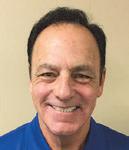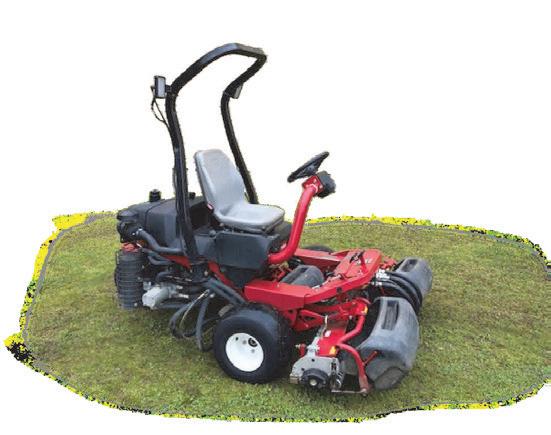
Summer 2023


Summer 2023
A Perspective from Turfgrass
Producers International PLUS





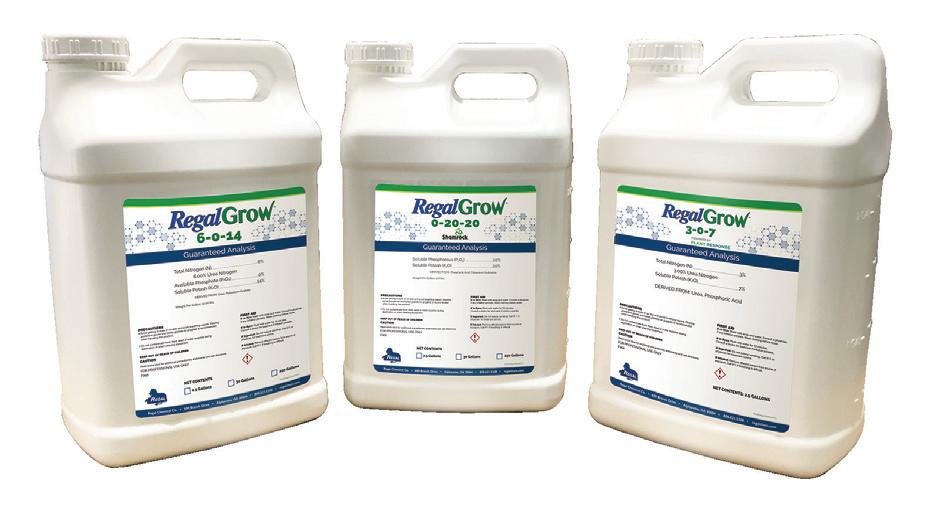


Hello again to all ATA members and Turf Times readers! I hope the start of your summer season has been a successful one. Since my last message we have been through spring, one of my favorite seasons of the year. Spring always throws us a few curveballs, and this year was no different. I coached my son’s baseball team, and we had a rescheduled rainout game rained out twice. Hopefully Mother Nature will be kinder this summer.
The ATA board recently met to discuss upcoming events. I really appreciate the willingness of our board members to serve and their passion for representing all our members. We will begin discussing recruitment to replace out-going board members very soon. I would encourage everyone to consider serving on the board if asked. If you are interested in serving and making a difference to our organization, please reach out to me or any other board member.
I want to say thank you to all involved with the Poa Annua Classic. Our goal every year is to have a day that we can fellowship together, play some golf, and help support the ATRF (Alabama Turf Research Foundation). Once again it was a great tournament. Thank you, Craig Potts, for giving us an insightful presentation. Thank you to Inverness Country Club for being a gracious host for the second year in a row. The golf course was in wonderful condition. I should have birdied every hole, but I didn’t. Thank you to all our sponsors. We would never be able to put together a great event like this without your help and support. Lastly, thank you to Kayla Cook for the organizing, planning and execution of this great event. Two upcoming events you should plan to attend are the Auburn Turfgrass Research Field Day at Auburn University on July 20th, and the Lawn and Landscape Workshop at Gardendale Civic Center on August 22nd. The Auburn Turfgrass Field Day is a great time to see and learn what Auburn has been working on to help you better manage your turfgrass in the future. Pesticide points will be available for the Research Field Day. The Lawn and Landscape Workshop will be an informative meeting with half of the day dedicated to educational presentations, and half the day being hands-on demonstrations. Please register for one, or both events, online at alabamaturf.org.
Right around the corner is the Deep South Turf Expo, hosted October 16th–19th in Biloxi, Mississippi. Be sure to register and attend this great Conference and Show. The Expo is a one stop shop for everything turfgrass: tradeshow, educational speakers, golf tournaments, tailgate celebration and much more. One of my favorite parts is the downtime for enjoying dinners with industry peers, blackjack with buddies, or sight-seeing of the Mississippi Gulf Coast.
This issue of the Turf Times has some great articles; Ecological Beneficial Turf – A Changing Landscape by Casey O’Neal, Auburn University, Julie Wang, University of Georgia and Nikolay Minaev, Mississippi State University, as well as our Feature article, Advancements in Sod Production by Dr. Casey Reynolds. Both are great articles about the turfgrass industry as we change and move forward. Also, our member spotlight article this issue is John Nabors of the Alabama Cooperative Extension System. John is a great asset to our industry, and we want to bring to light his accomplishments and highlight his career.
Finally, I wish everyone successful seasons, favorable weather, that lush green grass and, God willing, a great year as we share our passion of the outdoors.
Ben Williams
2023
ATA President

Ben Williams
2023 ATA
GOLD
• Envu
• Harrell’s, Inc.
• Jerry Pate Turf & Irrigation
SILVER
• Beard Equipment Company
• BWI
• Simplot
• SiteOne
BRONZE
• Corteva
• GreenPoint Ag
• Nufarm
• PBI Gordon
• Professional Turfgrass Services
• Regal Chemical Company
• Sur-Line Turf, Inc.
• Syngenta


Discounted
Expedited Delivery options
Place your orders 24/7
Yard Area Calculator


Dr. Becky Grubbs Bowling is an Assistant Professor and Extension Specialist with the University of Tennessee Institute of Agriculture (UTIA) specializing in Turfgrass Science and Management. She completed her B.S. and M.S. in Horticulture at Texas Tech University in 2010 and 2013 respectively before completing her Ph.D. in Crop and Soil Sciences at the University of Georgia in 2017. In her role, Bowling works in partnership with other faculty/ scientists, professional organizations, county extension agents, and others to conduct applied research and provide resources and programmatic support to the Tennessee turfgrass industry and beyond.
lans for the 2023 Deep South Turf Expo are percolating! Once again, our education committee has provided a thoughtful incentive to attend the Expo in the form of a great speaker line-up. Wednesday, October 18th’s keynote speakers include Becky Bowling, Ph.D. University of Tennessee, David McCall, Ph.D., Virginia Tech, and Travis Gannon, Ph.D., North Carolina State University.
Dr. Bowling’s program focuses on environmental turfgrass science with an emphasis on optimizing resource-use efficiency to promote environmentally and economically sustainable management practices for the turfgrass industry.
Dr. Grubbs presentation, “How has the Resist Poa project improved Poa annua control and management?” will focus on key project findings and implications from the “Resist Poa” project. In 2018, a team of 16 university scientists spanning 15 institutions embarked on a $5.6 million project (‘ResistPoa’) to limit the impact of annual bluegrass (Poa annua L.) in athletic, golf, lawn, and sod farm turf. The team’s multifaceted approach, funded by USDA-NIFA Specialty Crops Research Initiative (SCRI), had several objectives, including characterizing the nationwide distribution of herbicide-resistant P. annua populations. Potential weaknesses in the weed’s biology and growth characteristics are identified in order develop non-chemical control strategies. The study also identifies socio-economic constraints that may affect control strategies and stewardship of herbicide technologies and developing as well as delivering best management practices (BMPs).










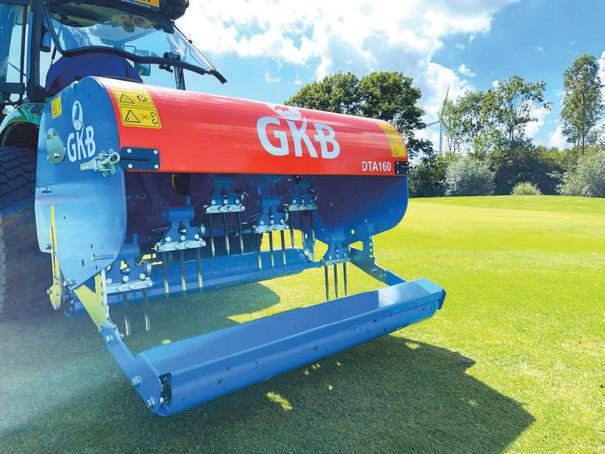
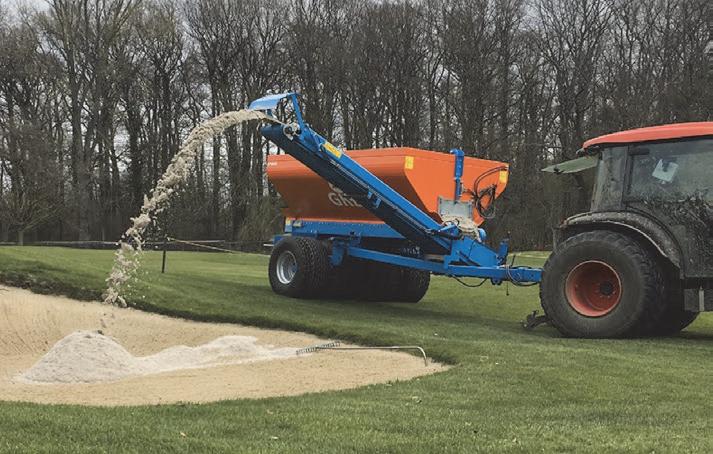














David McCall, Ph.D. is an assistant professor at Virginia Tech in the School of Plant and Environmental Sciences. His primary responsibilities as Turfgrass Pathologist are applied research (50%) and Extension (45%), with a 5% appointment in teaching. Dr. McCall’s research program currently focuses on the following:
a) remote sensing with unmanned aerial vehicles (UAVs or drones) to monitor disease epidemics and water inefficiencies across turfgrass systems,
b) field radiometry and thermal imagery for improving biological and environmental stress detection of turfgrass systems and specialty crops,
c) novel strategies to reduce pesticide inputs through targeted applications,
d) fungicide performance, efficacy, and ancillary benefits. Dr. McCall also has Extension responsibilities.
Dr. McCall says that his “applied research program is designed to aid my role in Extension, by providing practical disease management solutions to turfgrass professionals. I guest lecture for undergraduate and graduate courses in basic and advanced turfgrass management, plant pathology, and proper pesticide usage. Dr. McCall will speak on The Future of Drones and Precision Application Technology for Pest Management.

Travis Gannon, Ph.D., Professor, North Carolina State University, received his Ph.D. in Crop Science in 2011 from North Carolina State. He has worked at North Carolina State in several capacities since July 1999 and is currently a professor that institution. Dr. Gannon will speak on “Contemporary issues around pesticide use.”
According to Dr. Gannon, herbicides are commonly and effectively used to manage weeds in various agronomic systems including turfgrass systems. However, devising and implementing comprehensive weed management programs is a very intricate process and is complicated by many agronomic and other issues. This seminar will highlight many of the contemporary issues around pesticide use in turfgrass systems today including what’s involved in pesticide registration, off-target movement, and resistance.
The three presentations noted above are just a sampling of what is on the agenda! Please stay tuned for the complete schedule or check the DeepSouthTurfExpo.org website. The Expo will be held October 17th through the 19th this year. The Expo continues to change and adapt to further meet our attendee and vendor needs. The Scramble Golf Tournament at The Preserve is extremely popular, and the “Tailgate” session that follows has proven to be one of the most relaxing and enjoyable events. The Trade Show will highlight the latest in technology from our Sponsors. Thanks so much to our sponsors for supporting this event!


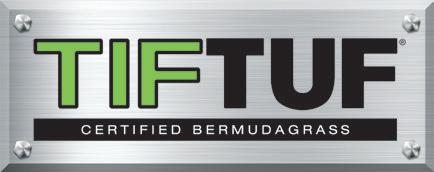

By Melanie Bonds
This year’s Poa Annua Classic returned to Inverness Country Club in Birmingham on April 17th. We appreciate Mark Jewell, Superintendent, and Inverness Country Club for hosting the Poa again this year! It was a gorgeous day for a golf tournament and the course was in excellent condition.
We also want to recognize our speaker, Craig Potts, CSFM. Craig retired last year after 27 years of grounds-maintenance at Texas A&M. Potts started at Texas A&M as assistant athletic fields manager in 1996. After 20 years, he was promoted to director of sports fields in the spring of 2016. In this role, he managed numerous sports facilities, working hard to keep fields in pristine condition. He shared with us his successes and management.

FIRST PLACE TEAM
Kyle Sheheane, Owen Coulson, Travis Frey and Chris Crutchfield
SECOND PLACE TEAM
Ben Anderson, Patrick Bell, Mike Romett and David Haven
THIRD PLACE TEAM
Glenn McWhirter, Chris Sheffield, Daniel Berry, Scott Corey
The ATA hosts the Poa each year to raise funds for the Alabama Turfgrass Research Foundation. Thank you to those sponsoring the event:







Members who attend the ATA Road Shows, the Deep South Turf Expo, Auburn Research Field Days, or any other event the Alabama Turfgrass Association is involved in, know John Nabors. He is a stalwart at these and other green industry meetings, enthusiastically advocating for and educating those that are a part of it.
John works as a member of the Alabama Cooperative Extension System and is also the Executive Director of the Alabama Green Industry Training Center. John completed a Bachelor of Science degree in Horticulture at Auburn University in 1998. Following that, in 2022 he completed a Master’s in Adult Education at Auburn. His areas of expertise include horticulture, safety & business, and workforce training.
Enjoyment of the outdoors and exposure to mechanical equipment initially sparked John’s interest in the field of turfgrass. He says, “Being able to spend some time on the farm as a kid can lead to trouble! I quickly learned that climbing over into the combine hopper or on top of the grain bin would earn my cousins and me an afternoon on the couch watching a soap opera…talk about some punishment! Over the years, I spent time growing up in several rural communities of Alabama, and in looking back, I realize how much I enjoy the country way of life. Many people in my family had gardening expertise and success with growing vegetables and flowers. In high school, I became interested in the landscape side to have some money in my pocket!”





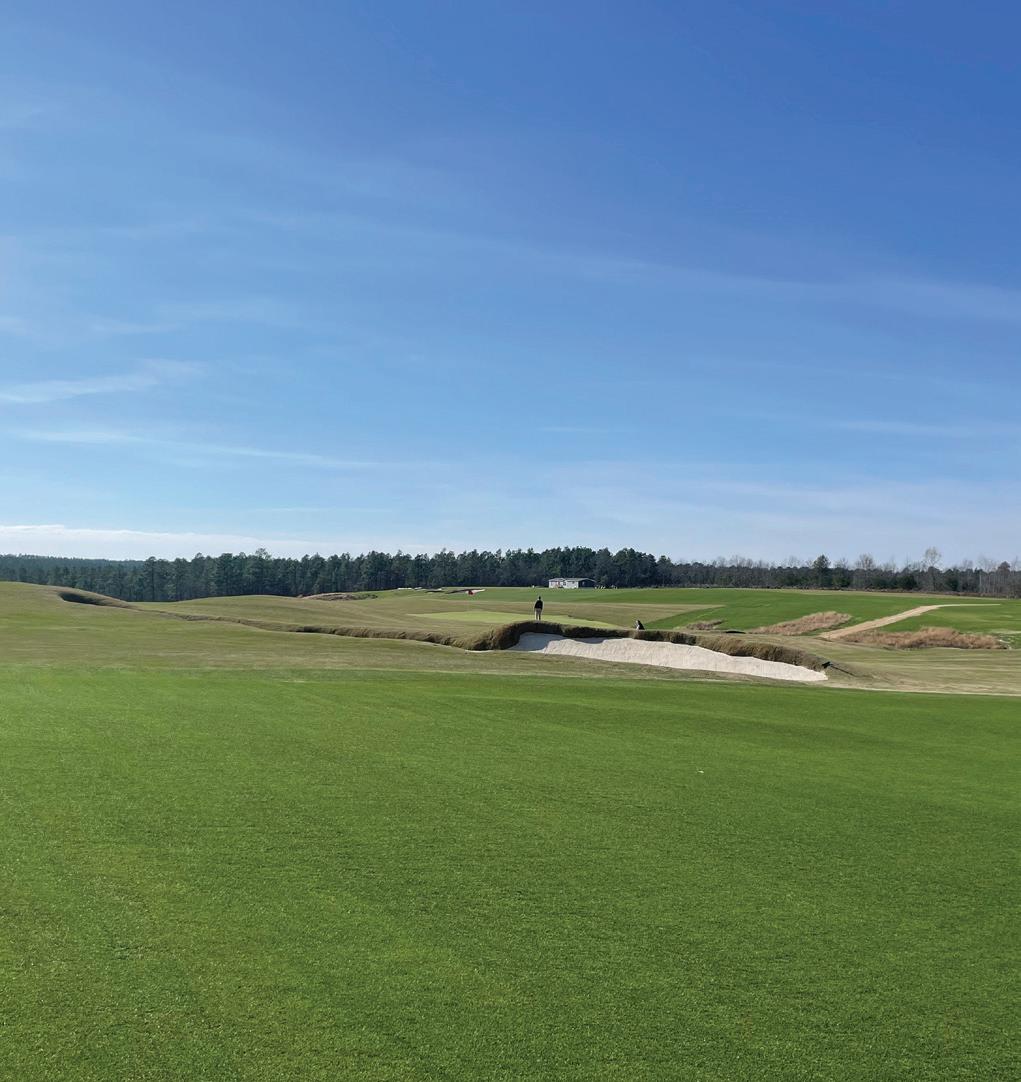


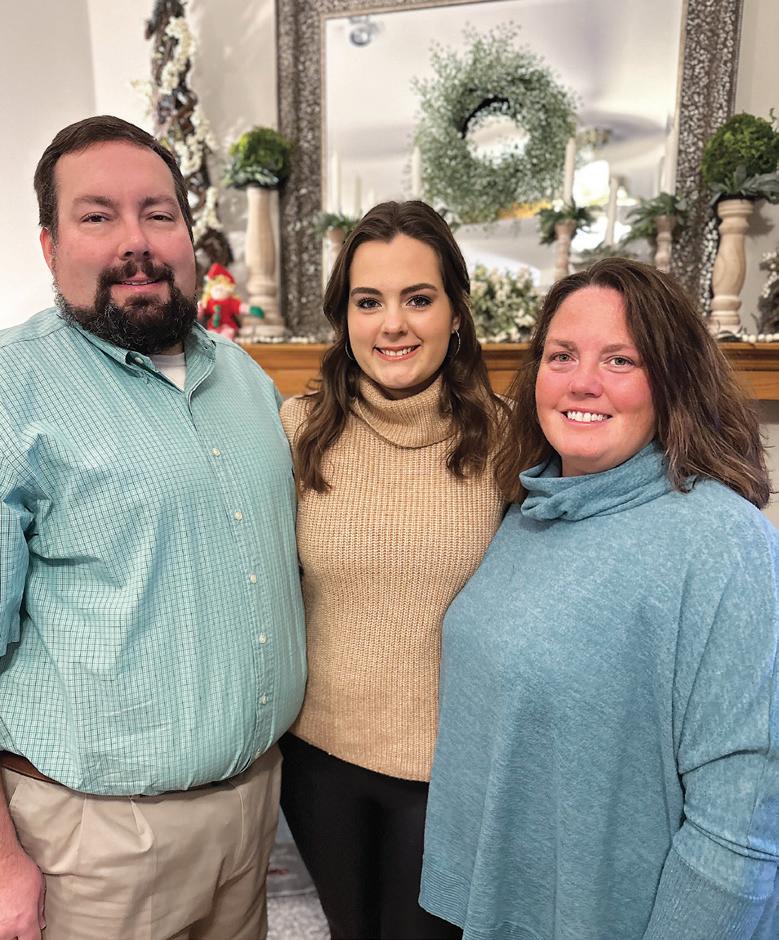


Many people, including family, friends, colleagues, and professors encouraged John along his career path, and he is grateful for this support. “I started out at Auburn University in Landscape Architecture, but once the professor asked for a rendering of myself as a class assignment, I knew I was in the wrong field! My artistic abilities plateaued at the stick-figure level! The good Lord led me right on over to a chair in Dr. Harry Ponder’s office in the Auburn Horticulture Department. If you know Dr. Ponder, you know the rest of the story! With that being said, I avoided Dr. Ponder an entire quarter close to graduation, because I knew he wanted me to interview with companies in Atlanta…except, I did not want to live in Atlanta! My avoidance did not work when he rounded a corner one day in the Funchess Hall stairwell and said, ‘Ahhhh, John! Where have you been? Go get ready for the interview, they are here today! You must meet with them!’”
Fortunately, another long-term mentor, horticulturist and educator with the Alabama Cooperative Extension Center, Dave Bradford, interviewed and hired John for a post-college job at Landscape Services in Birmingham, AL. Dave had by then retired from his extension career as district agent and was later hired to work as Landscape’s in-house county agent, plant doctor, and customer care official. Dave was a good source of guidance for John over the years, steering him towards an extension-based career and helping people in the industry.
The old leaders of Landscape Services taught John a lot. “Being the long-term establishment they are, you usually can find someone who has worked for them ‘back in the day’. Mr. Beaty Hanna, Bob Newton, and Tut Touchstone had an interesting way of working together and providing access to projects, events, and people that were unique to their time. Each of them provided plenty of advice when needed, but the way they allowed you to work, make mistakes on their dime, and grow as an individual, emphasized how they believed in helping people succeed with their projects.”
John has found a blessing in his current role, working for Alabama Extension. “I like being able to connect people in our industry with the information they need to succeed. It helps that I have experienced first-hand similar challenges and difficulties. I can relate to my clientele, understand their frustration, and help them focus on what needs to be done to solve their problem. Regulations are all around us, and I try to minimize the disruption by helping them see the easiest path to obtaining their license or certifications. From there, it is basically a wash, rinse, & repeat process for the next person. I also like being able to represent our industry to young people by talking with them at the Worlds of Work events and related technical career programs. The hard part of those days is wondering if our efforts are successful in reaching them and encouraging students to consider our industry as a viable option in their career path. I usually console myself that it is better to be there than not be there.”
In his extension career, John considers the greatest challenge to be “meeting the need to keep moving forward… just keep ‘rowing the boat’ and trusting it will work out. There are plenty of distractions and projects to work on within the time constraints. This is not unique to me, and we are probably all struggling with this at some level!”
John is married to Sara, a former dental hygienist. After many years in the dental industry, Sara decided to build on her college summertime employment experience in floriculture. In 2015, she opened a gardening company working for commercial and residential clients, completing boxwood pruning, flowers, and detail work for her clients. They have a daughter, Mallory, who is finishing up her first year at Auburn University studying Agricultural Business and Economics. John says, “I am so proud of her as a person, proud of her hard work and determination, and proud of her success!”
A few years ago, John and his family were able to leave the suburbs and move to a place out in the countryside. Content with his home, John says, “It’s nice to be able to mow some grass on flat land with no need to weed eat. I enjoy working in the garden, and convincing ol’Blue (a 1973 Ford tractor) to work as a bush hog occasionally. There are often lingering projects in the house to be completed. I like to spend time with my wife, check in on my daughter in Auburn, and see what the two farm cats, Charlie & Sylvia are getting into, while Molly, the Chihuahua, sleeps on the couch. What a life!”
John is a member of the Alabama Turfgrass Association, Alabama Nursery and Landscape Association, Southern Nurserymen’s Association, Alabama Association of County Agricultural Agents and Specialists, American Association of Pesticide Safety Educators, National Association of Landscape Professionals, and Epsilon Sigma Phi. He is the recipient of numerous awards including:
2022 — Epsilon Sigma Phi Alpha Pi Chapter Administrative Leadership Award
2012 — Commercial Landscape Maintenance Award for Birmingham Southern College presented by Alabama Nursery and Landscape Association
2004 — Horizon Award presented by Alabama Nursery and Landscape Association – This award is presented to progressive and innovative individuals who exhibit outstanding service in the Green Industry field
1999 — Commercial Landscape Maintenance Award for Carraway Hospital, Birmingham, AL presented by the Alabama Nurserymen’s Association
The ATA is extremely lucky to have John as a member. He is always willing to lend a hand, whether it is helping out at the registration table, or teaching Melanie and Tricia how to set up a virtual Road Show in 2020! John says, “There are many good things about our industry – the Green Industry! I think one of the best traits is our people. Over the past thirty years of industry experience, the people I encounter in our work treat others like family. I can think of so many in our industry that we may only see occasionally, but for the most part, when your paths cross each time, whether it is days, weeks, or months later, you can pick up, visit, and swap stories! Each of us should strive to keep this alive!”




By Casey O’Neal, Graduate Research Assistant, Auburn University
Julie Wang, Graduate Research Assistant, University of Georgia
Nikolay Minaev, Graduate Research Assistant, Mississippi State University
Movements such as “Save the Bees”, “No Mow May”, and “Let it Bloom June” are recently trending critiques of monoculture lawns. They highlight the lack of plant and insect diversity in single grass species or cultivar lawns. In recent years, programs like Operation Pollinator have moved the golf industries toward stakeholder interests by supporting research and outreach efforts to improve the ecological function of turf on their facilities. Similarly, the turfgrass industry must prepare to do the same for lawns. While replacing grass lawns with flower gardens, white clover fields, or meadows may be beneficial for pollinators and people in some areas, it ignores the documented want and need for lawns in modern society.

Nashville Soccer Club opened the largest soccer-specific stadium in the United States which made its inaugural debut in 2022.
Groundskeeper Adam Portenier fell in love with Latitude 36® Bermudagrass during his previous role at FC Dallas which led to the selection of this variety for the new GEODIS Park.
“You’re looking at five fields in the MLS with Latitude 36 and they’re probably all towards the top every year in quality and playability and coverage. You never see these fields beat up. I think just overall in this league Latitude is a very proven grass.”
–
Adam Portenier, Groundskeeper, Nashville SC
Monoculture lawns, typically a green frame around residential and commercial buildings, accumulate pests and consume a significant sum of inputs. Monoculture lawn alternatives, such as diversified, pollinator friendly, or flower lawns have been discussed; however, a warm-season alternative lawn with known beneficial impact and best management practices (BMPs) has not solidified in science or common practice. Understanding BMPs, and the benefits of these lawns, are crucial goals for the future of the turfgrass industry. The United States Department of Agriculture-National Institute of Food and Agriculture (USDA-NIFA) has funded the Refuge Lawn project to help highlight these goals.
The Refuge Lawn project consists of interdisciplinary researchers from Mississippi State University (MSU), Auburn University (AU), and the University of Georgia (UGA). The team set out to identify low-growing, flowering plants that would be easily established and managed in grass lawns, as well as provide the resources necessary to promote an abundant and diverse pollinator community. As some of the graduate students work on different aspects of the project, we would like to share some of our on-going research.
At Mississippi State University, Nikolay Minaev, working with Dr. Jay McCurdy, has been looking for flowering plants that could be easily established and propagated within turfgrasses commonly found in southeastern lawns. After evaluating various species based on their blooming properties and appearances in lawns, it was determined that spring beauty (Claytonia virginica) shows high potential for inclusion in warm-season lawns. Spring beauty is a perennial wildflower that is native to rich forests and low woodlands. It prefers moist, well-drained soil and light shade to part sun. It grows from a small corm or seeds. The growing season lasts from January through April in the temperate climate of the southeast, after which the plant senesces and lies dormant before emerging from corms the next year. The flowers are showy, pinkish white with deep pink veins, and open in clusters at the apex of the plant, adding a burst of color to the lawn during the early spring period. Additionally, it is a resource for pollinators such as the rare spring beauty bee, a small mining bee native to eastern North America.




The current understanding of spring beauty propagation is limited, hence we aim to address this knowledge gap by conducting a comprehensive study. The primary objective is to phenotype different populations of spring beauty and identify those with the most abundant and long-lasting bloom period, accompanied by high seed production and germination rates. This will allow for the selection of the most promising population for inclusion in lawns. In addition to identifying the optimal population, we are also exploring the most convenient method of propagation, with a particular focus on seeding. To achieve this, we are conducting experiments to find the optimal conditions for spring beauty germination, including testing various temperatures and probable treatments for quicker establishment.
Another project investigates the tolerance of spring beauty to commonly used pre-emergence herbicides in lawns. Our objective is to develop management practices that are safe for both turfgrass and spring beauty. By combining these different aspects of our research, we hope to provide a comprehensive understanding of spring beauty propagation and its integration into turfgrass lawns, while also promoting safe and sustainable management practices.
Julie Wang and Dr. Gerald Henry at the University of Georgia are investigating the BMPs for cultural management of a refuge lawn. Mowing height is one of the most well documented cultural factors affecting weed populations in turfgrass. Nearly all lawns are regularly mown for functionality and aesthetics. While mowing is relatively well understood
in terms of eliminating weeds, it can be similarly applied to encourage flower production and growth of refuge lawn. As part of the Refuge Lawn project, we are studying the effect of mowing height on flowering plants commonly found in turfgrass that have potential to be pollinator resources. We are currently measuring the survival, growth, and reproduction of white clover (Trifolium repens), Virginia buttonweed (Diodia virginiana), and common lespedeza (Kummerowia striata) in response to different mowing heights. The results may explain the persistence of flowering plants in turfgrass as well as their potential as floral resources for pollinators.
Fertilization, another common cultural practice in lawns, affects species competition and plant diversity. A high nitrogen (N) content increases turfgrass productivity and competitiveness with flowering plants adapted to limited N availability. This is especially relevant as fertility practices vary by turfgrass species. For instance, centipedegrass (Eremochloa ophiuroides) is adapted to lower maintenance regimes in contrast with hybrid bermudagrass (Cynodon dactylon x C. transvaalensis) that requires regular fertilization during peak growth. We are evaluating the competition between common flowering plants and turfgrasses under different fertility treatments, focusing on white clover, Virginia buttonweed, centipedegrass and hybrid bermudagrass. Preliminary results suggest that low fertility inputs hinder hybrid bermudagrass growth, leading to an open canopy, which encourages flowering plant growth. On the other hand, exorbitant amounts of fertility on centipedegrass only enhances flowering plant competition and further plant growth. The understanding of flowering plant and turfgrass dynamics will help create BMPs for both homeowners and the turfgrass industry.


1.
•
•
•
2. Where is it used?
• High demand athletic fields:
• High traffic areas: Horsetracks, goalmouths, and tournament crosswalks.


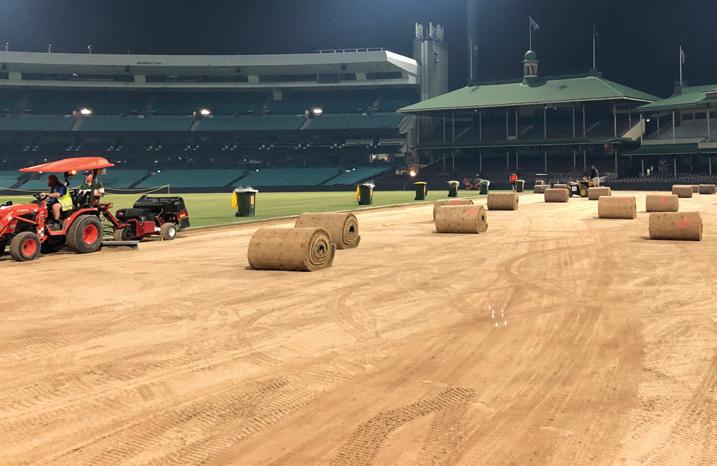


At Auburn University, Casey O’Neal and Dr. David Held want to know what insects benefit from integrating flowering plants into warm-season grasses. Beginning in fall 2021, we established plots of seven potential flowering plant species in lawns at the AU Turf Unit, Town Creek Cemetery, and Kiesel Park in Auburn. These sites consist of established turfgrass lawns that host a range of common warm-season turfgrasses including bermudagrass and centipedegrass. The flowering species include spring beauty, white clover, and Virginia buttonweed, allowing us to connect our research with the teams at MSU and UGA. In 2022, the flowering sites were monitored for visitation by insect pollinators, and the insects were collected and identified. Due to the drought in 2022, data collection at these sites will continue in 2023. From these collections, we can establish a pollinator network. This network will show which flowering plants provide resources for the largest number of pollinators, and which plants provide resources for rare or threatened pollinators. While the exact number is unknown, it is expected that there are more species of bees in Alabama than any other southeastern state, and currently over 500 species have been identified in Georgia alone. With such a high diversity of insect pollinators,

it is important to include flowering plants that serve as many of the native pollinators in the southeastern US as possible. By combining the knowledge gained from our respective studies, we can establish a model refuge lawn with known BMPs and beneficial impacts on pollinators. To keep up with us and the rest of Refuge Lawn project’s work, or to contact any of the researchers involved, please visit our website at www.refugelawn.com
This work is supported by Agricultural and Food Research Initiative grant no. 2021-67013-34145 from the USDA National Institute of Food and Agriculture.


Beard Equipment 27 www.beardequipment.com/locations/mobile
BWI Companies, Inc. 31 www.bwicompanies.com
Coosa Valley Turf Farms 11 www.coosavalleyturffarms.com
Corteva Agriscience Inside Front Cover www.corteva.com
Crossroads Sod Farm 13 www.csfsod.com
Greene County Fertilizer Co. 25 www.greenecountyfert.com
Jerry Pate Turf & Irrigation Back Cover www.jerrypate.com
Modern Turf, Inc. 25 www.modernturf.com
North Georgia Turf Company, Inc. 15 www.ngturf.com
Progressive Turf Equipment Inc. 17 www.progressiveturfequip.com
Regal Chemical Company 5 www.regalchem.com
Riebeling Farms, Inc. 11 riebelingfarmsinc@gmail.com
Smith Seed Services 31 www.smithseed.com
Sod Solutions 19 www.sodsolutions.com
South Dallas Turf Farm 21 www.SouthDallasTurf.com
Southern Specialty Equipment .............. 29 www.ssequip.net
STEC Equipment ............................................... 9 www.stecequipment.com
Super-Sod 7 www.supersod.com
Sur-Line Turf, Inc. 29 www.surlineturf.com
The Turfgrass Group 3 www.theturfgrassgroup.com
Weed Man 23 www.weedmanfranchise.com
Winstead Turf 23 www.winsteadturffarms.com





By Dr. Casey Reynolds, Executive Director TPI
Turfgrass Producers International (TPI) has members who produce and sell turfgrass seed and sod in almost every U.S. state and over 30 countries. As I travel to visit with them, speak at conferences, write magazine articles, etc., I often get to speak with producers first-hand about what they’re experiencing in their local markets. This often includes the good and the bad, and oddly enough no matter where I go, the themes are usually similar. From a farm’s perspective, demand is up; costs are up; labor is short; and where did all the truck drivers go? From a market perspective, consumers and policy-makers increasingly just don’t understand natural grass lawns and their benefits, and in many areas of the country, they are quite literally trying to write them out of new construction, through local ordinances which ban or dis-incentivize the use of grass.



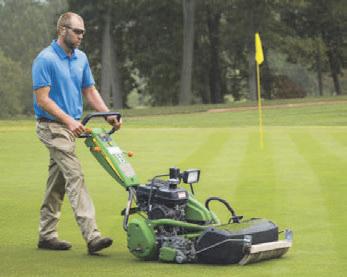
Someof t he l ightestmowersint heirclass, our SL PrecisionCut™ and E-Cut Hybrid walk-behinds allow effortless turning and better engagement with the turf.




Our rough, trim and surrounds mowers great ly increase efficiency and trimming capability. From reels to rotary decks, we have you covered in the rough and surrounds.



Our new A-Model PrecisionCut and E-Cut Hybrid Fairway Mowers give you more control and better results, thanks to our revolutionary TechControl display.


Andy Beauchamp - Birmingham/Middle AL (864) 344-5200
abeauchamp@beardequipment.com
Brad Rounsaville - South AL (228) 424-2468 brounsaville@beardequipment.com
Bubba Jones - Northwest AL (864) 419-3391 bjones@beardequipment.com
Mickey Pitts - Montgomery/Central AL (334) 757-8277
mpitts@beardequipment.com
Craig Ketelsen - Northeast AL (864) 419-0183
cketelsen@beardequipment.com
So where does this leave us? In the short run, housing is still quite hot and the demand for grass ebbs and flows with it. In the long run, will the next generation of consumers and home-buyers value or even want lawns, landscapes, natural grass athletic fields, and golf courses? The short answer to that question is that it’s up to us. But let’s revisit that a little later.
Data from the U.S. Department of Housing and Urban Development indicates that as of March 2023, purchases of new homes increased for a third consecutive month. Construction of new homes rose in February and sales of existing homes surged after a 12-month decline. The U.S. Census Bureau shows that New Housing Units are still strong, despite a recent drop-off from the post-covid boom (Figure 1). As such, turfgrass producers in most areas of the country including Alabama sod producers, are still reporting strong sales, high demand, and sometimes low inventory.
While this is good news for producers and others in the green industry who rely on lawns, landscapes, sports fields, and golf courses, it is no surprise to anyone that costs are also up. The U.S. Bureau of Labor Statistics has some useful tools on its website at https://www.bls.gov. If you’re a data junky, or just a little curious to see it on paper, you can find some helpful charts and graphs that track the costs of goods and services over many years. It should be no spoiler that food, energy, raw materials, transportation, and warehousing are all up when compared to pre-Covid levels. A little good news is that all 2023 Producer Prices Indexes are down when compared to 2021 and 2022.
Like many industries, turfgrass seed and sod producers routinely look for efficiencies to reduce these costs and often find them in new equipment, automation, digitalization, GPS/
Remote Sensing technologies, new techniques or practices, and so on. It would be difficult to list them all here, but out of necessity comes innovation and there is always a better way to do things. There are certainly plenty of those opportunities out there just as there are in other segments of the green industry.
Now, let’s change course from a production perspective to a market perspective, which is just as likely to impact the state of our industry. With that in mind, what is the current and future consumer perception of lawns and other green spaces? I suspect many of you have seen recent headlines such as “Kill Your Lawn Before It Kills You”, “American Lawns: Ending the Toxic Yard” and so on. If we need further proof of that, simply Google the phrase “Lawns are” and you can see the top search terms that people are entering into common Google queries. The top hits include Lawns are “bad, stupid, wasteful, colonialism, useless, ecological disaster,” and so on.
While it is easy to sometimes write these off as op-eds, there is definitely consumer research that shows we as an industry should take these seriously. Eighty-two percent of consumers are familiar with sustainability, up from 55% in 2007. Additionally, between 51 and 95% of consumers will pay more for products aligned with their values on sustainability. Counter that with the fact that less than half of consumers are aware of the environmental benefits of lawns and other green spaces. It also differs by generation where consumers between 18 and 34 years old are less aware of the benefits than consumers 35 years old and older. It also doesn’t help that the next generation of home buyers are right now playing middle, high school, and college sports on an increasingly large number of plastic, synthetic turf athletic fields.

So, what does this mean for the future of green space? It means that we as the green industry in general, need to take our story of the benefits of lawns and other green spaces and shout it from the rooftops. We absolutely need to be educating the current and next generation of consumers on the ecosystem services that lawns and other green spaces bring to the urban-suburban interface. Just as one example, a 2018 research paper indicated that for one urban/suburban city venue, 89% of the carbon that was captured or sequestered, along with 88% of the water quality regulated and 81% of the runoff regulated for that entire city was being done by managed grasses. Follow-up question, do your customers, neighbors, city council members, and others know it? I most often find they don’t. If that is the case, please refer them to www.TheLawnInstitute.org where they can find many of the benefits of lawns. Share the information with everyone. Voters need to know the true story as well as those making purchasing decisions and politicians setting public policy in communities all over the United States.
In the last 12 – 18 months alone, I have had to respond to turfgrass bans or restrictions all over the country, and yes, they include northern states and southern states, eastern states and western states, and red states and blue states. That seems so ironic because one thing that the Covid-19 pandemic restrictions highlighted was that once people stayed at home, they often realized they wanted to spend more time outdoors enjoying their lawns and landscape. This is the primary reason our industry weathered that storm so well. Interestingly, prior to the pandemic, Turfgrass Producers International (TPI) funded consumer research on the perceptions of lawns and found that once you explain the many benefits of turfgrass to people, they understand it and are willing to continue investing in natural grass lawns.







So, how do we do this in a meaningful way? One industry initiative right now that you may have heard about is a proposed USDA Research and Promotion Program, aka “checkoff,” for sod production. There are currently 22 USDA Research and Promotion Programs (aka checkoffs). They have a long, proven history of funding research and promotion of agricultural products having been around since the 1960s. Since then, the current 22 checkoffs combined routinely raise 1 billion dollars each year to fund research and promotion of their products. Many, if not all, checkoff programs arise out of an industry’s need to push back against market threats or shifting consumer trends, as well as to fund research on improving products or techniques. The soybean checkoff this year alone identified up to $400 million in unrealized market potential and then funded research to address it.
Current estimates put a potential U.S. Sod Checkoff program at raising around $14 million annually to fund local and national research, as well as the promotion of lawns and other green spaces. Who knows what potential value it could be to our industry, but there is little doubt that everyone in the green industry, not just sod producers, could benefit by having a checkoff program promoting natural grass. Many of the associations representing our industries have gone on record saying they support the sod checkoff initiative. The National Association

of Landscape Professionals, the Sports Field Managers Association, the US Golf Association Green Section, the American Farm Bureau, and others have stated that they understand the need for national and local research and promotion efforts to protect and promote green space. If you want to learn more about the proposed sod checkoff, visit www.SodCheckoff.org to stay up to date on the latest information.
Now, as we talk above about the current and future status of our industry, I’d just like to add a quick editorial perspective. One sod producer recently wrote about rising inflation, increasing fuel costs, and an unpredictable stock market in TPI’s Turf News magazine. When I say “recently,” that article was published in 1999. We had another sod producer write about ever-increasing water restrictions and the artificial turf market. That was in 2004. The point being, the challenges and opportunities we have today aren’t often that drastically different from those we faced years ago. Going forward, we should all be proud of how our industry responded to the changing dynamics of the past. Also, you should have comfort in knowing that Alabama Turfgrass Association members live and work in a great industry, and with vision, proper planning, and last but not least, proper investment in our industry’s future, we can make sure it thrives for many years to come.
Alabama
Alabama
P.O. Box 70
Auburn, Alabama 36831
Tel: (334) 821-3000
Fax: (334) 821-3800
Email: mailbox@alaturfgrass.org www.alaturfgrass.org
Published
Leading
Tel: (615) 790-3718
Fax: (615) 794-4524
Email: info@leadingedge communications.com
Executive
Alabama
EXECUTIVE
President
Vice
Secretary
Past
BOARD
Industry
EX OFFICIO / EDUCATION
David Han, Ph.D.
Auburn University (334) 844-3980 handavi@auburn.edu
Jim Jacobi, Ph.D.
Alabama Cooperative Extension System (205) 879-6964, Ext. 19 jacobjc@auburn.edu



The ProCore 648s builds on the tremendous legacy by incorporating proven technology and even more innovative features while preserving the time tested design elements that changed the way you aerate. The onboard controller is continuously monitoring key operating parameters to improve after aeration turf condition and allow the operator to easily target coring head drop and raise. Proven reliability, improved performance, and exciting innovation - that’s what makes the ProCore 648s the new superior choice.

The Golf Irrigation Sales and Service Team at Jerry Pate Turf & Irrigation is here for you. Our team of Account Executives, Golf Irrigation Inside Sales team members, and Golf Irrigation Projects Specialists to help with all of your golf irrigation seasonal needs and projects. Likewise, our Irrigation Field Service Team is available to assist with many levels of irrigation inquiries or technical solutions.

